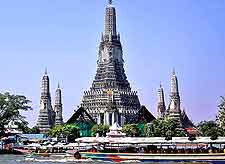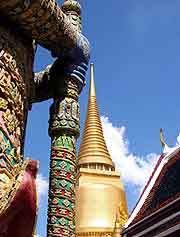Bangkok History Facts and Timeline
(Bangkok, Thailand)

The grand capital city of Thailand and a crucial part of the country's history, Bangkok is known for its spectacular Buddhist temples, royal palaces and canals.
Formerly nicknamed the 'Venice of the East', the city's waterways are now largely gone, and it has changed immeasurably in the last 50 years on the back of rampant growth and development, becoming South-East Asia's most dynamic city. Although founded only two hundred years ago, it has a marvellous historic district known as the Rattanakosin Isle, and plenty of old culture.
Early Period
The history of Bangkok goes back to the 14th century and the small trading and farming settlements lining the banks of the Chao Phraya River, known as Bang Makok. At that time, the region was ruled by the great Ayutthaya (Ayuddhaya) dynasty, centred in the city of the same name, with its magnificent monuments still visible today.
As Ayutthaya's maritime trade increased, Bangkok became an important customs outpost, collecting dues from trading ships bound for Ayutthaya, as well as removing and storing their cannons before they were allowed to continue.
The Siamese Revolution and the Siege of Bangkok
By the late 17th century, this was an important strategic town with a Western-style fort overlooking the river, designed by a French military architect and containing a mixture of Portuguese, French and Siamese military personnel. The Temple of Dawn (Wat Arun Rajwararam), on the riverbanks, dates from this period and is one of the few truly ancient sights in the city. However, it should be noted that its characteristic tower was added much later on by kings Rama II and III, in the early 19th century.
At this time, Bangkok's governor, the Chevalier de Chaumont, requested more French troops, a move which sat badly with the Siamese nobility. During the resulting Siamese Revolution, the pro-Western King Narai was overthrown and his Christian family and a number of missionaries were all murdered. Also killed was Constantine Phaulkon, a Greek adventurer and the king's favourite advisor.
Revolutionary leader Phra Phetracha (also frequently spelt as Bedraja, Petraja and Petratcha) seized the throne, vowing to banish French military forces and foreign influences from Siam. In 1688, some 40,000 Thai revolutionary soldiers besieged the city's fortress at the Siege of Bangkok. Subsequently, all ties with Western governments were broken, remaining defunct until the late 19th century. However, Siam and Bangkok were still active in Sino-Siamese-Japanese trade.
The Burmese Invasion and its Aftermath
In 1767, Burmese armies razed Ayutthaya and occupied the region, including Bangkok, until Phraya Tak, later known as King Taksin, repelled the invasion. The fall of the Ayutthaya Kingdom led to the foundation of the modern city by Taksin, who built his capital at Thonburi, across the Chao Phraya river from the present day city. His rule and life only lasted until 1782, when a coup overthrew him and the kingship was taken by an army general.
The Rattanakosin era that followed saw the building of the Grand Palace, royal temples and many other spectacular structures under the Chakri Dynasty. They also named the city Krung Thep (City of Angels), as their new capital of Siam.

History of the 19th Century and Later
During the 19th century, Western traders and missionaries arrived in increasing numbers, especially during King Chulalongkorn's (Rama V) reign. Siam was at its zenith, controlling much of the region, and the wealth poured into the city to make it one of the grandest of the era. The much-respected Rama V greatly admired European architecture and his reign has left its mark in the Grand Palace complex, the Abhisek Throne Hall, the Vimanmek Teak Palace and even the more recent Government House.
The 20th century saw the further modernisation of Bangkok, including the 1932 abolishing of the absolute monarchy via a coup, along with the unification and renaming to Thailand of the whole of Siam, with Bangkok as its proud capital. The art deco Democracy Monument (Anusawari Prachathipatai) and the Hua Lamphong railway station date from this era.
During WWII, Bangkok's port was bombed by the Allies after Thailand signed a military alliance with the invading Japanese, allowing them free passage across Thailand. Forced to pay war reparations afterwards, Thailand suffered years of rudderless leadership from absent kings and endless coups, and the city fell into decline.
During the Vietnam war era, US military aid propped up a series of junta governments, with several more coups and dictators ruling from the city. By the time Thailand had served its purpose as a vanguard against communism, the country had embraced the Asian tiger model seen in South Korea and Taiwan, and Bangkok was at its centre.
In the history of Bangkok, the seventies were traumatic non-the-less, as the country suffered democratic growing pains and Bangkok bore the brunt of bloody student revolts. At the same time, rampant growth saw the city grow ten-fold in a matter of decades resulting in haphazard planning, traffic congestion and the rise of a whole new CBD in the Silom and Sukhumvit districts.
Even as late as 2006, the city made world news when yet another coup ousted the controversial Thaksin Shinawatra from power. The troubles continue to fester with his rural supporters laying siege to the central district for three months in 2010.
Meanwhile, the rest of Bangkok goes about its business in one of Asia's most commercially important cities, mingling with millions of tourists who enjoy the rich vein of historic culture that is so well preserved here.
 The grand capital city of Thailand and a crucial part of the country's history, Bangkok is known for its spectacular Buddhist temples, royal palaces and canals.
The grand capital city of Thailand and a crucial part of the country's history, Bangkok is known for its spectacular Buddhist temples, royal palaces and canals.